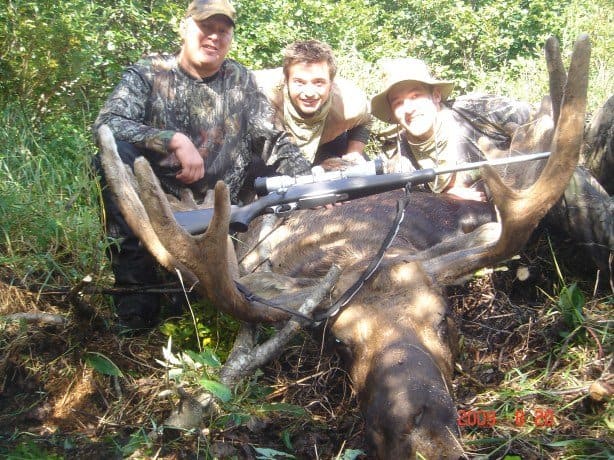Shiras Moose are smaller than Alaskan Moose with different coloring and habitat preferences. Shiras Moose are typically found in the mountainous regions of the western United States, while Alaskan Moose inhabit the forests and tundra of Alaska and northern Canada.
Despite their differences, both species are majestic creatures that are sought after by wildlife enthusiasts for their impressive antlers and elusive nature. In the world of moose, there are two distinct species that capture the attention of nature lovers: the Shiras Moose and the Alaskan Moose.
These magnificent creatures differ not only in size but also in their preferred habitats and physical characteristics. While the Shiras Moose is known for its smaller stature and lighter coloration, the Alaskan Moose is renowned for its massive size and darker coat. Despite these disparities, both species share a similar allure, drawing admiration from those who appreciate the beauty and grace of these majestic animals.
Shiras Moose
The Shiras Moose, scientifically known as Alces alces shirasi, is a subspecies of Moose found in North America.
Physical Characteristics
Shiras Moose are smaller in size compared to other Moose species, with adult males weighing around 800-1,200 pounds.
They have long legs and a humped shoulder, with antlers that can span up to 4 feet in width.
Habitat And Range
- Shiras Moose inhabit the Rocky Mountains region, including parts of Colorado, Wyoming, Idaho, Utah, and Montana.
- Found at elevations ranging from 5,000 to 10,000 feet, these Moose prefer dense forests and alpine meadows.

Credit: issuu.com
Alaskan Moose
The Alaskan Moose, also known as the Alces alces gigas, is the largest subspecies of moose found in North America.
Physical Characteristics
The Alaskan Moose typically weighs between 1,200 to 1,600 pounds, with males having impressive antlers that can span up to 6 feet in width.
Habitat And Range
The Alaskan Moose primarily inhabits the boreal and mixed forests of Alaska, as well as parts of western Yukon and British Columbia.
Comparing Behavior
When observing the behavior of Shiras Moose and Alaskan Moose, it becomes apparent that the differences in their social structure, diet, and feeding habits significantly impact their respective ecosystems. Let’s delve into the nuances of their behavior to understand the distinct characteristics of these majestic creatures.
Social Structure
Shiras Moose: Shiras moose tend to be more solitary in nature, primarily due to the scattered distribution of food sources in their habitat. They are often found roaming alone or in small groups, and their territories are carefully guarded, leading to minimal interactions with other moose.
Alaskan Moose: In contrast, Alaskan moose typically exhibit a more gregarious behavior, forming loose social groups especially during the mating season. They are often seen in larger herds, where individuals communicate through vocalizations and body language to establish hierarchy within the group.
Diet And Feeding Habits
Shiras Moose: The diet of Shiras moose mainly consists of aquatic plants and leaves, requiring them to reside in areas with ample water sources. They are known to frequent marshy or wetland areas to satisfy their dietary needs.
Alaskan Moose: Conversely, Alaskan moose have a diverse diet, incorporating a wide range of browse, twigs, and shrubs. They are well-adapted to feeding on vegetation in diverse landscapes, including forests and open meadows.

Credit: missionak.com
Human Interaction
When it comes to human interaction, both Shiras Moose and Alaskan Moose have fascinating relationships with humans. Whether it’s through hunting and conservation efforts or the thriving industry of tourism and wildlife viewing, these majestic creatures have become an integral part of human society. Let’s explore how these interactions unfold.
Hunting And Conservation
Hunting has been a traditional activity associated with moose, providing sustenance and resources for generations. However, alongside the hunt, the importance of conservation has come to the forefront, ensuring the long-term survival of these species. Conservation organizations work tirelessly to protect moose habitats and maintain sustainable hunting practices. Through regulated seasons, quotas, and education, hunters contribute to the preservation of these magnificent animals.
Tourism And Wildlife Viewing
Tourism has boomed around the world, and viewing wildlife in their natural habitats has become a popular activity. Both Shiras Moose and Alaskan Moose draw tourists to their respective regions, eager to catch a glimpse of these gentle giants. Wildlife viewing tours allow enthusiasts to observe moose grazing peacefully in their natural surroundings, capturing unforgettable moments. With responsible ecotourism practices, these encounters promote awareness about the importance of preserving moose habitats and fostering a deeper appreciation for these creatures.

Credit: issuu.com
Frequently Asked Questions Of Shiras Moose Vs Alaskan Moose
What Is The Difference Between A Shiras Moose And An Alaskan Moose?
The main difference between a Shiras Moose and an Alaskan Moose lies in their size and habitat. The Shiras Moose is smaller and usually found in the Rocky Mountains, while the Alaskan Moose is larger and inhabits the forests and tundra of Alaska.
Conclusion
While both the Shiras and Alaskan moose are majestic creatures, they differ in size, habitat, and behavior. Understanding these differences is crucial for wildlife enthusiasts and hunters alike. Whether you’re drawn to the allure of the Shiras or the impressive size of the Alaskan moose, both species contribute to the rich diversity of the natural world.



